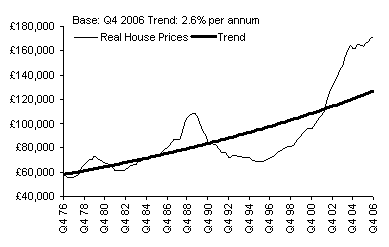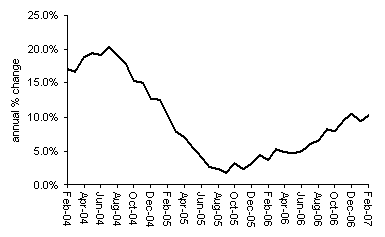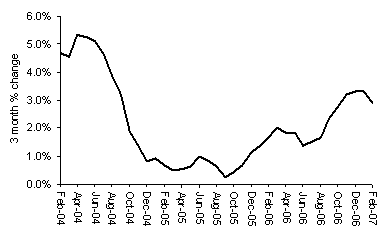- Types of Mortgage Explained
- Which Mortgage Type Is Right For Me?
- Mortgage Repayment Guide
- Remortgage Guide
- First Time Buyer Mortgages
- House Price Comparison
- How Much Can I Borrow
- Joint Ownership
Specialist UK Mortgages...
Interest rate hikes beginning to take their toll
- House price growth returns to double digits, but underlying demand weakening
- Higher interest rates and stretched affordability are causing demand to wane
- Yet supply constraints and buy-to-let interest will support prices in the short term
Headlines (provisional) |
February 2007 |
January 2007 |
Monthly index * Q1 '93 = 100 |
352.5 |
350.2 |
Monthly change* |
0.7% |
0.3% |
Annual change |
10.2% |
9.3% |
Average price |
£174,706 |
£173,225 |
* seasonally adjusted
Commenting on the figures Fionnuala Earley, Nationwide's Chief Economist, said:
“The Bank of England spared homeowners a second consecutive rate rise in February, but its latest forecasts suggest that one more rise could still be on the cards. While the three recent rate rises now seem to be starting to take their toll on the market, not all indicators are cooling just yet. Buyer interest and mortgage demand are waning, but the supply of properties coming onto the market remains low. This lack of supply will mean that house price inflation will remain firm for a while longer, before gradually easing. Prices rose by a steady 0.7% in February, pushing the annual rate of house price growth back into double digits to 10.2%. The price of a typical house now stands at £174,706. This is more than £16,000 higher than this time last year and the equivalent of a rise of more than £40 per day.
Another rate hike is not yet a done deal
“The Inflation Report and MPC Minutes did not give as much clarity on the future direction of interest rates as we had hoped. This is perhaps unsurprising given the continued split of opinion among MPC members and the highly uncertain inflation outlook. Overall the Bank’s inflation forecast was relatively balanced. While the Inflation Report analysis showed that building in another quarter point rise in rates would bring inflation to its 2% target at the critical two year horizon, it also showed an undershoot both before and after. The case for another rate increase is not therefore cut and dried and weaker inflation, retail spending and business activity data since the forecasts were finalised will have reduced the need for hasty action. The latest MPC minutes suggested that while the Committee has a hawkish bias it is firmly in ‘wait and see’ mode, and while the risks are significantly on the upside, another hike in rates is not yet a done deal.
Market is taking longer to respond to recent rate rises…
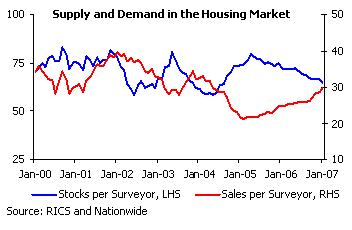
“At the start of the last rate rising cycle, when the Bank of England implemented the first of five interest rate rises in November 2003, property sales by estate agents took an immediate knock and fell quite sharply for the next 15 months. This time the response is more moderate. Seven months on from the first of the recent rate rises, sales are still rising. Why the difference? One crucial difference is that the inflation outlook now is still relatively benign so financial market expectations are more moderate than in 2003. Back then fixed mortgage rates shot up by 1.1 percentage points in the three months before the first rate rise. In contrast, fixed mortgage rates rose by just 0.25 percentage points in the lead up to the rate increase in August 2006. Given the more modest impact on mortgage costs, it shouldn’t be that surprising that the market is taking slightly longer to respond this time around.
...but lower demand is beginning to feed through…
“For now, supply issues are keeping an upward pressure on prices as property sales have continued to rise, while the number of properties placed on the market has been falling. However, demand indicators suggest that the tightness in the market will soon begin to ease. Mortgage approvals for house purchase recorded their largest monthly fall since the early 1990s and were down from 128,000 in November to 113,000 in December. In addition, estate agents have now recorded two successive months of falling buyer enquiries after 18 months of solid gains.
“The buy-to–let sector, which provided an important boost to the market in 2006, remains very firm. Although the rate of growth of lending has decelerated, gross buy-to-let lending was still 43% higher in 2006 H2 than a year earlier. Some of this will reflect refinancing, but the number of buy-to-let mortgages is 20% higher than at the end of 2005. Looking forward the buy-to-let market is not immune from higher interest rates and we expect this to dampen new demand somewhat by putting further pressure on rental yields, although 57% of buy-to-let investors still claim that they expect to acquire further properties during the next 12 months . Therefore, the strength and momentum that built up in the market in 2006 will not unwind immediately, but there are increasing signs that recent rate rises are cooling the market.
…eventually leading to smaller house price gains.
“House price gains in January and February have now averaged 0.5% per month, significantly below the 1.1% average in the second half of 2006. It is difficult to know whether this is already a reflection of weaker demand or whether it reflects normal volatility around a turning point in the market. Certainly, the 3 monthly growth rate has fallen from 3.3% last month to 2.9% now, but even if monthly house price gains remain at around 0.5%, the annual rate of house price growth will remain close to 10% until late spring due to the relatively weaker performance of prices this time last year. By the second half of 2007, we continue to expect to see a more pronounced slowdown in the annual rate of house price growth. This will be a reflection of higher interest rates and stretched affordability curbing the demand of residential buyers, along with some slowdown in buy-to-let demand. We do not expect a severe fall in confidence, even if interest rates were to rise once more, due to the continued strength of the economy and the labour market in particular.”
Fionnuala Earley Katie Harper
Chief Economist Press Officer
Tel: 01793 656370 Tel: 01793 656215
fionnuala.earley@nationwide.co.uk katie.harper@nationwide.co.uk
Average UK House Price
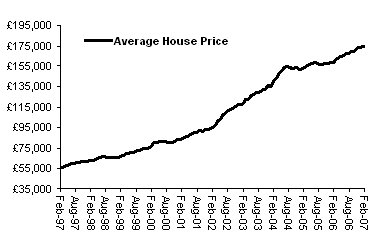
Long Term Real House Price Trend
Annual % Change in House Prices
3 months on previous 3 months % change
Historical Data

Notes:
Indices and average prices are produced using Nationwide's updated mix adjusted House Price Methodology which was introduced with effect from the first quarter of 1995. Price indices are seasonally adjusted using the US Bureau of the Census X12 method. Currently the calculations are based on a monthly data starting from January 1991. Figures are recalculated each month which may result in revisions to historical data.
The Nationwide Monthly House Price Index is prepared from information which we believe is collated with care, but no representation is made as to its accuracy or completeness. We reserve the right to vary our methodology and to edit or discontinue the whole or any part of the Index at any time, for regulatory or other reasons. Persons seeking to place reliance on the Index for their own or third party commercial purposes do so entirely at their own risk. All changes are nominal and do not allow for inflation.
Think carefully before securing other debts against your home, your home may be repossessed if you do not keep up repayments on your mortgage.
Go Direct.co.uk is a trading style for website purposes of Go Direct UK Ltd.
Go Financial Services is a trading style of Go Direct UK Ltd which is an appointed representative of Personal Touch Financial Services Ltd which is authorised and regulated by the Financial Conduct Authority. Registered in England & Wales Company 5703224. FCA Number 456600
We normally do not charge a fee for mortgage advice, however this is dependent on your circumstances. Our typical fee would be £349





